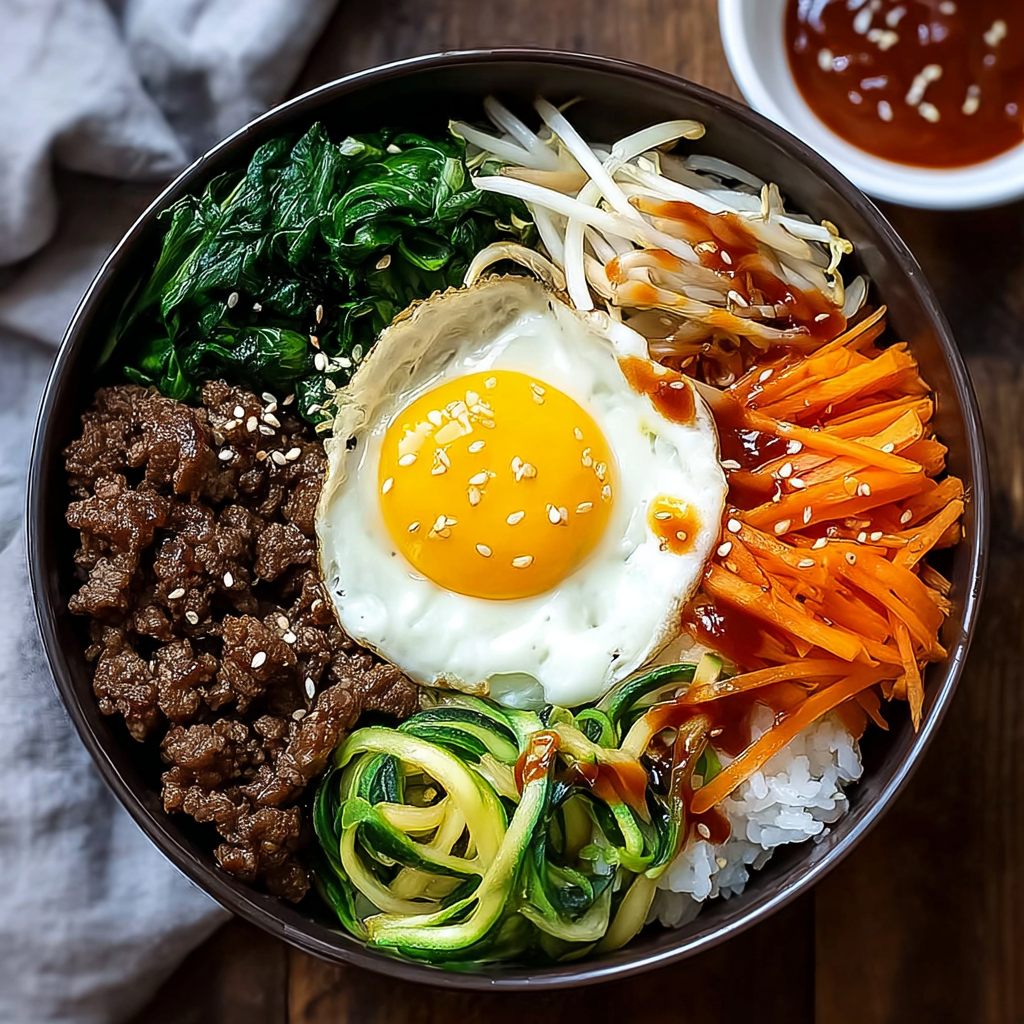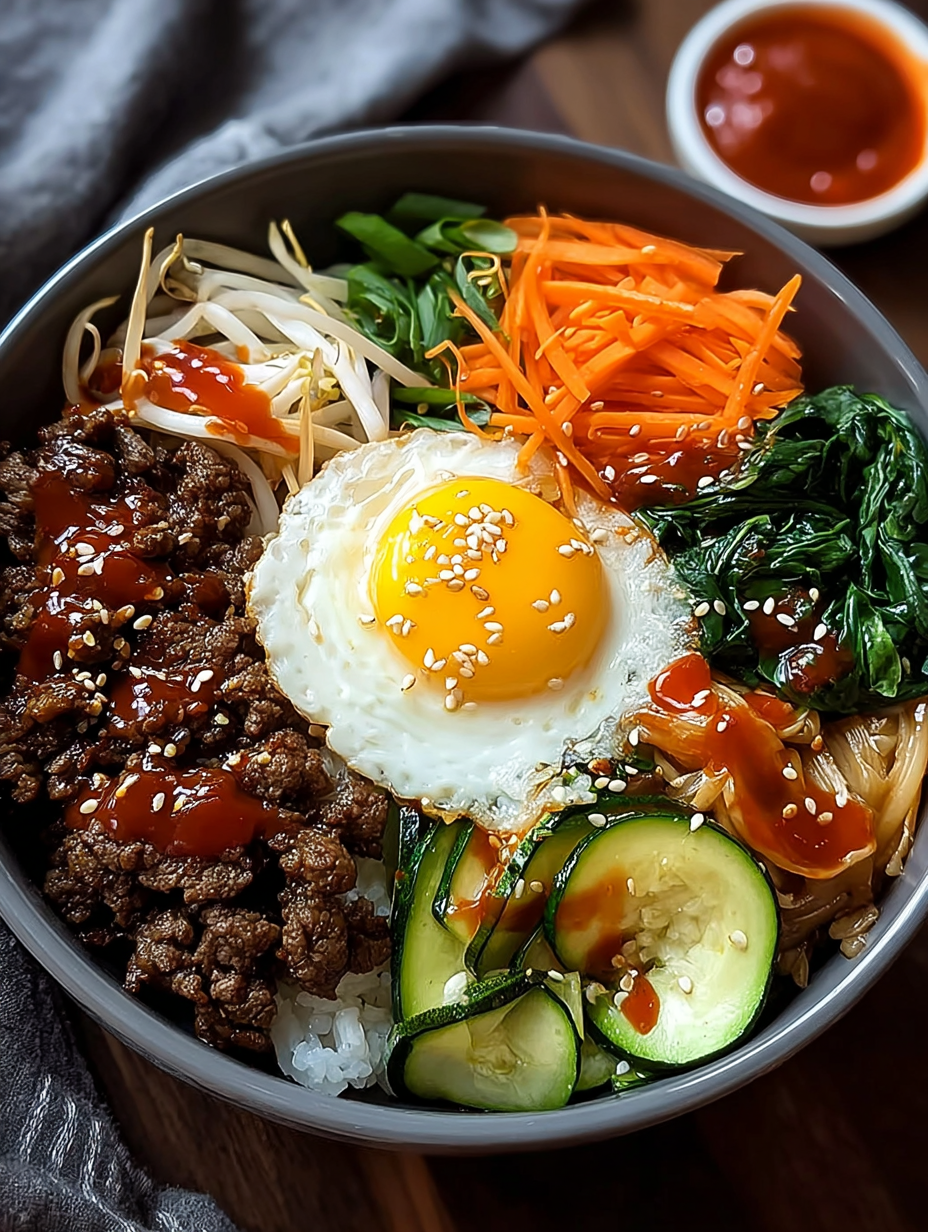 Save Pin
Save Pin
This Korean Beef Bibimbap Bowl brings together savory marinated beef with fresh vegetables and a perfectly fried egg on a bed of warm rice. It is a visually stunning and flavorful dish that offers a satisfying mix of textures and tastes, ideal for any meal of the day. Rooted in traditional Korean cuisine, bibimbap means mixed rice and celebrates harmony through a customizable combination of ingredients. Whether you want a quick weeknight meal or a dish to impress guests, this recipe delivers a delicious and balanced experience in under an hour.
I first made this during a busy weeknight and was amazed at how quickly it came together. My family loved the mix of flavors so much that it became a regular on our rotation.
Ingredients
- Ground beef: lean cuts provide enough flavor without excess fat choose fresh meat with a bright color
- Short-grain white rice: sticky texture essential for authentic bibimbap rinse well to remove excess starch
- Carrots, spinach, zucchini, and bean sprouts: fresh or organic when possible for the best taste and texture contrast
- Gochujang sauce: Korean red pepper paste that brings heat and umami adjust the amount based on your spice preference
- Sesame oil: adds a nutty aroma and depth high-quality oil will make a noticeable difference
- Soy sauce: low sodium is best to control saltiness while enhancing savory notes
- Garlic and sugar: balance flavor in the marinade and sauce
Step-by-Step Instructions
- Prepare the Rice:
- Cook your rice according to the package instructions, usually about 20 minutes, until it is tender and sticky enough to hold together well.
- Cook the Beef:
- Heat a skillet over medium-high and cook the ground beef, breaking it apart as it browns evenly. This should take around 5 to 7 minutes. Drain any excess fat if necessary.
- Add Flavor:
- Stir in the gochujang, soy sauce, and sesame oil with the beef. Reduce heat to low and let it simmer gently for about five minutes to absorb the flavors fully.
- Sauté the Vegetables:
- In a separate pan, warm some sesame oil over medium heat. Add sliced carrots, zucchini, spinach, and bean sprouts and sauté until just tender but still crisp, which takes approximately seven minutes.
- Fry the Eggs:
- Using a non-stick pan, cook eggs sunny-side up so the whites set but the yolks remain runny for about three minutes.
- Assemble the Bowls:
- Divide the cooked rice into bowls. Top each with the seasoned beef mixture, then the sautéed vegetables, and finally place the fried egg on top. For extra flavor, drizzle more gochujang or sprinkle sesame seeds.
 Save Pin
Save Pin
Storage tips
Keep leftovers in airtight containers in the fridge up to four days. For longer storage, freeze cooked beef and vegetables separately for up to three months. Reheat gently in a pan or microwave, stirring halfway to heat evenly, then assemble with fresh rice and eggs.
Ingredient substitutions
If you prefer, substitute the ground beef with ground chicken or turkey for a lighter option. For a vegetarian version, use firm tofu or tempeh marinated in the same sauce. Feel free to swap vegetables with seasonal choices such as mushrooms or kale for varied textures and flavors.
Serving suggestions
Serve your bibimbap with a simple cucumber salad tossed in rice vinegar for a refreshing contrast. You can also offer kimchi on the side to add traditional Korean tang and crunch. Lightly toasted seaweed sheets make a fun garnish that enhances the umami notes.
Cultural context
Bibimbap is a classic Korean dish known for its harmonious mix of ingredients, traditionally eaten with a gochujang sauce that varies in heat and sweetness. It originated as a practical way to use leftovers but has since become a beloved staple representing balance and nutrition in Korean culinary culture.
Pro Tips
- Always toast your sesame oil slightly before adding vegetables to release its full aroma
- Do not skip rinsing your rice it makes a big difference in texture and prevents clumping
- Marinate the beef for at least 30 minutes or overnight for deeper flavor infusion
Commonly Asked Questions
- → What is bibimbap?
Bibimbap means 'mixed rice' in Korean, combining rice with marinated meat, sautéed vegetables, and typically a fried egg for varied textures and flavors.
- → Can I make this dish vegetarian?
Yes, replace beef with tofu or tempeh and add more vegetables like mushrooms or bell peppers for delicious plant-based alternatives.
- → How do I get the perfect fried egg?
Fry the egg sunny-side up until whites are set but yolk remains runny, providing a rich, creamy addition to the bowl.
- → What rice works best in bibimbap?
Short-grain rice is best for its sticky texture that holds the ingredients together while absorbing flavors well.
- → How should I store leftovers?
Keep components separately in airtight containers in the fridge for up to three days to maintain texture and freshness.
- → What vegetables complement this dish?
Carrots, spinach, zucchini, and bean sprouts are classic, but you can also include kale, radishes, or mushrooms for variation.
